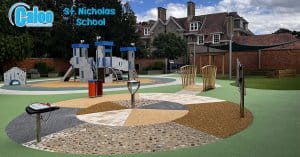 Add My Company
Add My Company

Playground design is a critical aspect of creating an engaging, safe, and inclusive environment for children to play, learn, and grow. It requires a careful balance of creativity, safety considerations, and an understanding of child development. This article will provide a comprehensive guide on playground design, covering essential elements, considerations for inclusivity, and safety measures.
Essential Elements of Playground Design
Choosing the Right Equipment
A classic playground staple that caters to a wide age range.
They come in various sizes and styles, suitable for different ages.
Climbing Structures
These help children develop strength and coordination.
They promote balance and cooperation between children.
These can be educational, featuring numbers, letters, or puzzles.
These can stimulate imaginative play.
Sensory Play Touch
These can be stones, wet pour rubber, mulch, and sand.
Sound, Musical Play: Bells, drums, chimes, tubes, Glockenspiel.
Zoning
Active Zone
This area is for equipment like swings, slides, and climbing structures.
Quiet Zone
This area is for less strenuous activities like playing with sand or water tables.
Social Zone
This area, equipped with benches and tables, is for socializing and resting.
Safety Zones
Relates to fall height from equipment and the distance between the equipment and its surrounding areas.
Inclusive Playground Design
Accessible Equipment
Ensure that all children, including those with disabilities, can use the playground. This could include wheelchair-accessible swings and low-level play panels.
Sensory Play Elements
Incorporate elements that stimulate all senses, like musical instruments or textured panels.
Safe Surfacing
Use surfacing materials that can cushion falls and are easy for wheelchairs to navigate, like rubber or engineered wood fiber.
Safety Measures in Playground Design
Age-Appropriate Design
Equipment should be suitable for the age group it is intended for. For example, toddler swings should be separate from swings for older children.
Equipment Spacing
There should be enough space between equipment to prevent accidents.
Regular Inspections
Regular maintenance and inspections can help identify and fix any potential hazards.
In conclusion, playground design is a multifaceted process that requires careful consideration of various factors. By ensuring that the design is engaging, inclusive, and safe, you can create a playground that will be loved by children and appreciated by their caregivers. Our expert advisors will attend your site and prepare a bespoke design based on the desires of the client, the safety requirements of the equipment and user, and the budget.
Read more about safety in Children’s Play and Leisure here: https://www.hse.gov.uk/entertainment/childs-play-statement.htm

For more information on GET THE BEST ADVICE FOR DESIGNING YOUR NEW PLAYGROUND talk to Caloo Ltd

